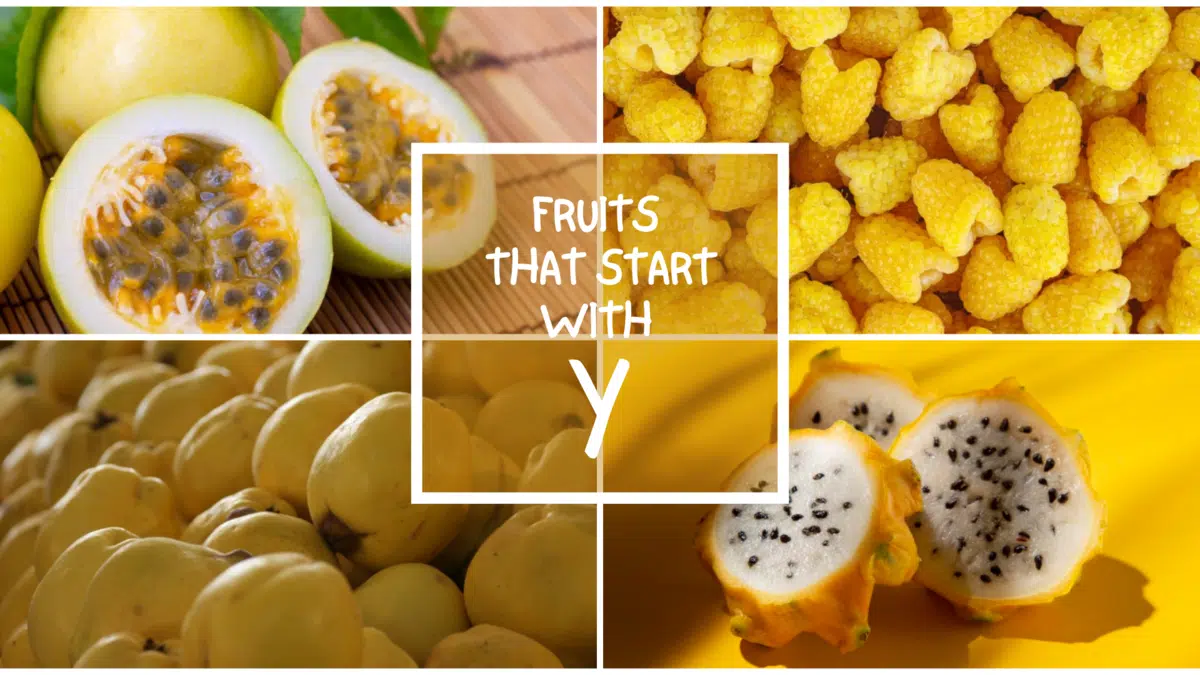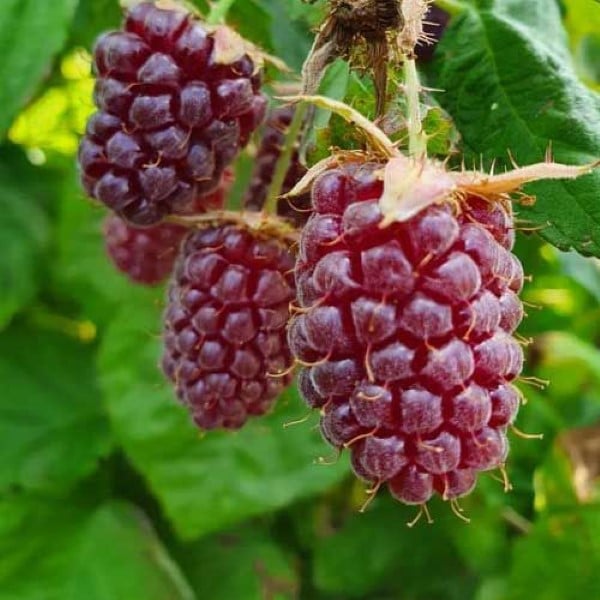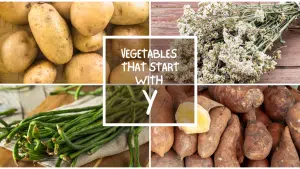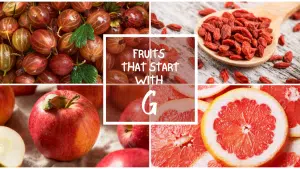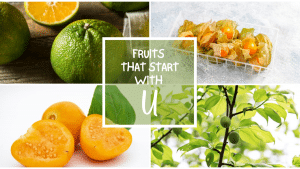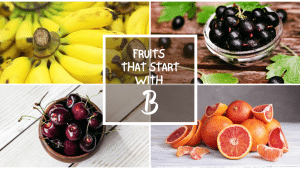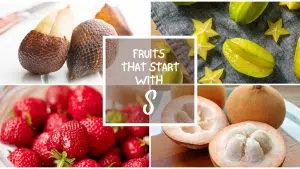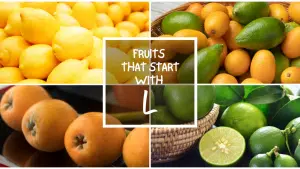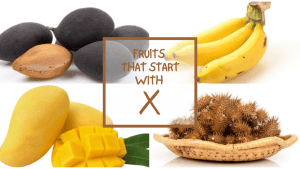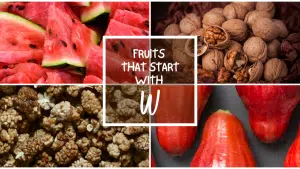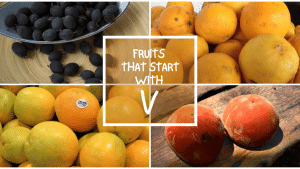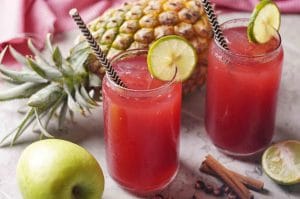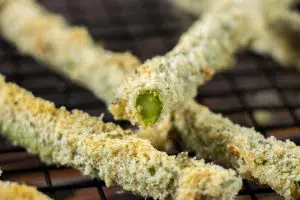All The Fruits That Start With Y
Important Note: When you buy through our links, we may earn a commission. As an Amazon Associate we earn from qualifying purchases. Content, pricing, offers and availability are subject to change at any time - more info.
Fruits are an essential part of the human diet since they contain various nutritional values essential for our nourishment. Different fruits have different names based on where they originated from or where they grow. Very few things begin with the letter Y, but the fruits beginning with the letter Y are very popular worldwide. To assist you in expanding your fruit menu, here are all the fruits that start with Y.
- Yaca
- Yuzu
- Yali Pear
- Yellow Passion Fruit
- Yellow Grapes
- Yellow Guavas
- Yellow Pear Tomato
- Yellow Squash
- Yangmei Fruit
- Yellow Plum
- Yellow Dragon Fruit
- Youngberry
- Yellow Sapote
- Yellow Himalayan Raspberry
- The Final Letter
Yaca
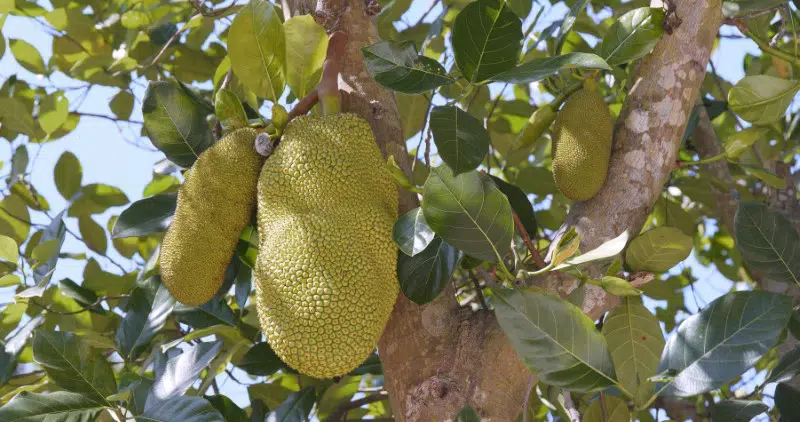
The Yaca is scientifically known as Artocarpus heterophyllus, and it’s a species from the fig, mulberry, and breadfruit family. In most regions of the world, the Yaca is commonly referred to as the jackfruit. The origin of the Yaca can be traced from the southern regions of India, Malaysia, Sri Lanka, and the rainforests of Indonesia. Currently, the Yaca is grown in almost every country in the world, especially in the tropical lowlands. The jackfruit usually varies in size, with the largest recorded Yaca listed as weighing as much as 55kg, 90 cm long, and 50 cm wide. A Yaca tree can produce up to 500 fruits per year. The jackfruit is also considered the national fruit of countries such as Bangladesh and Sri Lanka and some Indian states, namely Kerela, Tamil Nadu, and Karnataka.
When ripe, the Yaca tastes very sweet with a subtle banana-pineapple flavor and an aromatic smell that is always pleasing to smell. A ripe Yaca surface happens to be a little rough and turns from a greenish-yellowish color to green once mature. When pruned, the inner part of the Yaca produces a milky and sticky liquid that is very hard to get rid of unless with oil or any solvent of that nature. The Yaca can be consumed whether ripe or unripe. The Yaca is very versatile as a vegetable also since it can be used to prepare several native dishes of the areas they originate from, such as es teler in Indonesia, halo-halo in the Philippines, and as an ingredient in making cakes and custard. When using Yaca with rice, the leaves can be used as a wrapper when steaming. The seeds from the Yaca are also edible once cooked and are said to have a milky, sweet taste. The seeds can be prepared by boiling, roasting, or baking and used as snacks or in the preparation of desert. The younger and tender leaves are used as a vegetable supplement in other regions. The fruit is a source of minerals and vitamins C and B and antioxidants such as carotenoids that give the jack fruit its yellow color. The health benefits range from the prevention of heart diseases, cancer to muscle degradation, and cataracts due to the antioxidizes. The nutrients also aid in reducing the risks of constipation, diabetes, high blood pressure, skin problems, and ulcers. The Yaca is so popular that it can be found in almost all market places worldwide.
Yuzu
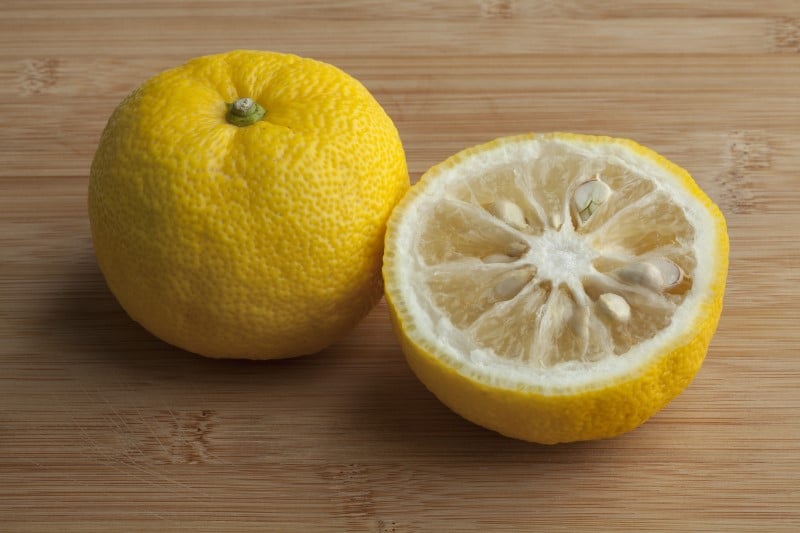
Yuzu is a citrus fruit scientifically known as Citrus Junos, with origins that can be traced back to the east Asian regions of the world. The Yuzu is mostly cultivated in east Asia, but New Zealand, Spain, Australia, France, and Italy have recently started cultivating them. It is believed that the Yuzu is an F1 hybrid of the mandarin orange and ichang papeda. The yuzu tree is usually very small, almost shrub-like, and is always covered with thorns, and the leaves are always very heavily scented. The Yuzu resembles a grapefruit with recorded size being between 5 cm – 8 cm in diameter, though with an uneven skin. Still, some trees can produce even large-sized fruits depending on the growth conditions. The color of the Yuzu depends on the maturity and ripeness of the fruit. The yuzu fruits are always very aromatic, and the taste varies from fruit to fruit depending on the tree or growing conditions. Unfortunately, the Yuzu isn’t consumed very much as a fruit, but it is mainly used for its aromatic zest and its juice, which is used with the same applications as the lemon juice. In Korea, the Yuzu is used to prepare the Yuja tea where it is sugar peeled, depluped, thinly sliced, then mixed with hot water and with Yuja-Cheong (marmalade). It is also used as an ingredient in making salad and fruit punch. Like any other citrus fruit, the Yuzu has many health benefits, such as reducing the risk of gout, eye infection, scurvy, cancer, and heart diseases resulting from the antioxidants, vitamin C, and minerals in the fruit. The Yuzu is also used for cosmetic purposes due to its strong aroma. The skin is squeezed to extract oil which is sold as a fragrance. The US recently banned the importation of both the yuzu tree and fruit.
Yali Pear
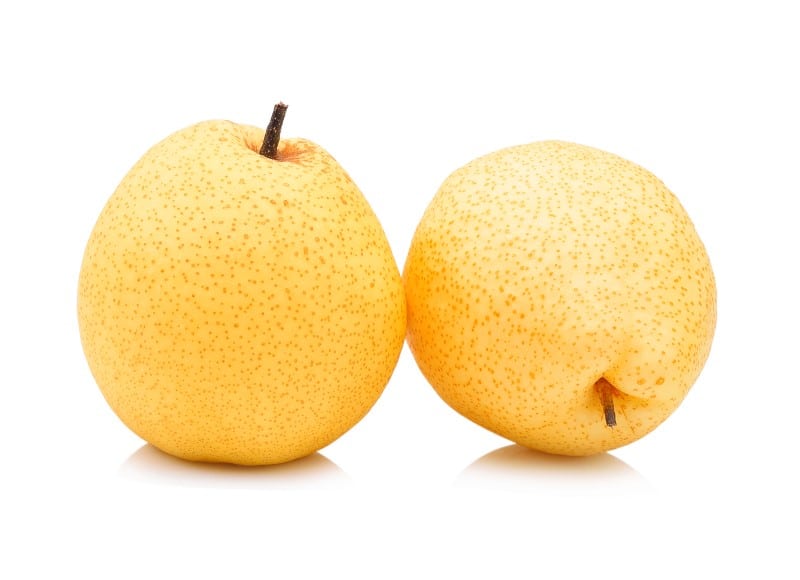
The Yali pear is commonly referred to as the Chinese pear in honor of its place of origin. The scientific name of the Yali pear is Pyrus bretschneideri. It is an interspecific hybrid pear species native to the north China region. The Yali pear is tear-drop shaped with one slanted on one side with a large base and a narrow neck that is usually long and brown. When unripe, the skin is always green in color, transforming to yellow once ripe. The Yali pear’s flesh is predominantly white, crisp, and moist, encasing a central core consisting of a few black seeds. The Yali pear is softer than the other kinds of pears; hence it is susceptible to bruising. When ripe, the Yali pear has a very juicy, sweet, and mild tart taste with a very pleasing smell. The Yali pear can be eaten raw, though it is used as a vegetable in some regions, where it can be roasted, grilled, or even blended to produce juice. Some recipes that involve using the Yali pare include squash soup, sliced with Thai basil to make a green salad, poached with wine, then served with lamb, pork, and any chicken dish. The Yali pears are also a great compliment to nuts such as almonds and hazelnuts. The health benefits of the Yali pear include blood sugar control, improved prenatal health, cancer prevention, and improving your heart health. This is due to the fruit containing minerals and vitamins such as potassium, vitamin K and C, copper, folate, and magnesium. These pears are available in the US at select grocery stores.
Yellow Passion Fruit
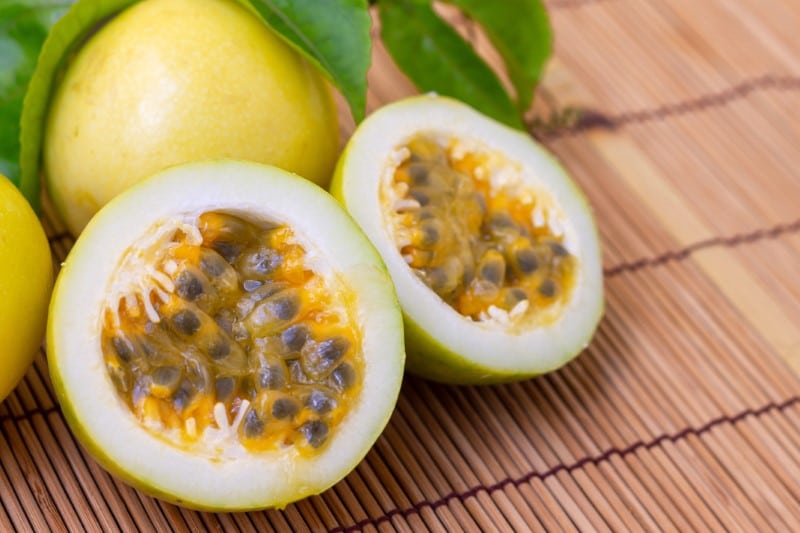
The yellow passion fruit is predominantly referred to as sweet granadilla and scientifically as Passiflora ligularis. This fruit is native to South American regions of the Andes Mountains, areas of Peru, Costa Rica, and Bolivia. Apart from its native land, the yellow passion fruit grows in Africa and Australia. This fruit has very simple leaves and unique flowers that appear greenish-white in color. The fruit size is between 6 – 8 centimeters long and 5-7 centimeters wide. The outer coating of the fruit is usually hard and very shinny and smooth though the interior is made of soft padding that protects the seeds, which are black and hard, surrounded by a transparent pulp. When mature, the passion fruit turns from green to yellow, usually with a very aromatic scent. The pulp is the edible part of the fruit, and it’s usually very sweet and a bit acidic with little floral tastes. The pulp can be eaten raw or even cooked. The pulp and the seeds can be used in cocktails, fruit salads, or served atop ice cream. The seeds can be extracted, and the pulp juice can be boiled and used to make jams, sauces, ice cream, and pies. To neutralize the acidity of the pulp, you are recommended to add sugar and a bit of cream to the pulp. The yellow passion fruits are cultivated in the US on a small scale, but you can still find them at all grocery stores countrywide.
Yellow Grapes

Yellow grapes are a species of grapes also referred to as centennial grapes. These grapes are believed to have originated from California. The color of the grapes’ skin is yellow and possesses a thin inky-cyan outer shell. Yellow grapes are spherical and medium-sized and also happen to be seedless. The yellow grapes’ taste is much sweeter than the other kind of grapes, and the wine produced from it has medium-high acidity and high tannins. Yellow grapes can be eaten along with ice cream, slushies, or even use them to top up your salad. The health benefits of yellow grapes include boosting your immune system and lowering blood pressure and cholesterol in your body. With their antioxidant components and properties, these grapes help prevent cancer. The potassium levels are high, thus protecting the heart from diseases. Thanks to vitamin K and minerals like calcium and magnesium present in the grapes, you are assured of strong bones.
Yellow Guavas

The yellow guava is scientifically known as Psidium guajava, and it grows on an evergreen shrub that is native to the Caribbean, Central, and South American continents. The guava is now grown in most subtropical and tropical regions of the world. The guava size varies depending on the tree and the growth conditions. The outer surface of the guava is usually soft and shiny. When unripe, the guava is usually green and very hard, but when it matures, the color turns yellow, and the rigidity of the fruit softens. The inner flesh part of the guava tends to vary in color, with the colors ranging from pink, red or white. Mature guavas possess a very aromatic scent that can also be used to spot which guavas are ready for harvesting, especially if you are harvesting them by hand. Yellow guavas have a high sugar content that gives the guavas a very sweet taste. Guavas can be eaten raw or as a beverage, especially in Latin American countries where there is a particular average known as Agua fresca, which is very popular in Mexico and is mainly made of guava. In countries like the Philippines, guavas are used in the preparation of sinigang. Guavas can also be used in the making of fruit salads. Guavas are very beneficial to your health since it helps regulate your blood pressure and sugar levels, improve your vision, assist with indigestion, prevent scurvy, and prevent anemia and urolithiasis. Guavas are also available in the US.
Yellow Pear Tomato
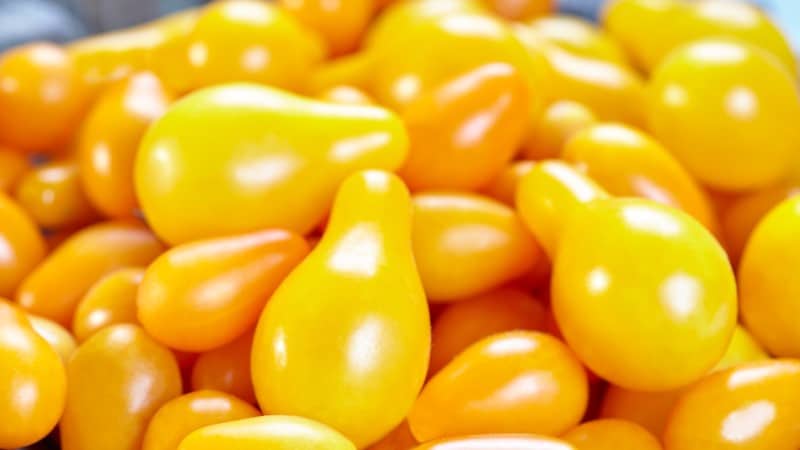
Yellow pear tomatoes belong to a group of indeterminate heirloom tomatoes, which appear in a wide range of yellow, orange, and red tomatoes. The yellow ones are the most common. The Yellow pear tomato is also commonly referred to as teardrop tomato. They have the shape of a pear but are a bit smaller, and they have a sweet taste. They are native to America, introduced in Europe in the 16th century. They were introduced in England and the United States shortly after, where they are commonly grown and used. They are commonly used for flavoring soups. They can be consumed alone while fresh or used to make preserves. Harvesting them is quite easy because they come off easily from the tree when they are ripe. They have a completely yellow color when they are ripe. They are easy to grow and rear in your garden. They can be used for fresh salads and summer sandwiches because of their juicy and sweet taste. They have lycopene, an antioxidant feature that has anti-cancer properties and reduces the risk of cardiovascular diseases.
Yellow Squash

Yellow Squash is also referred to as Summer squash, and its scientific name is Cucurbita pepo. They are usually harvested when young and immature, while the skin is still tender and edible. It comes in two varieties: straight neck and crookneck.
Crookneck squash usually has a bulbous bottom and slender neck that’s curved at the top, and it contains larger seeds and thicker and waxier skin than other squash varieties. Yellow squash vegetables have Vitamins A, B6, and C, fiber, folate, potassium, magnesium, phosphorus, and riboflavin, essential for maintaining a healthy body. It is also rich in Manganese, which aids in boosting bone strength and helps the body’s ability to process carbohydrates and fats. Yellow squash can be fried into croquettes or fritters, frozen for winter, sliced into noodles, and grilled with other summer veggies, among other uses.
Yangmei Fruit
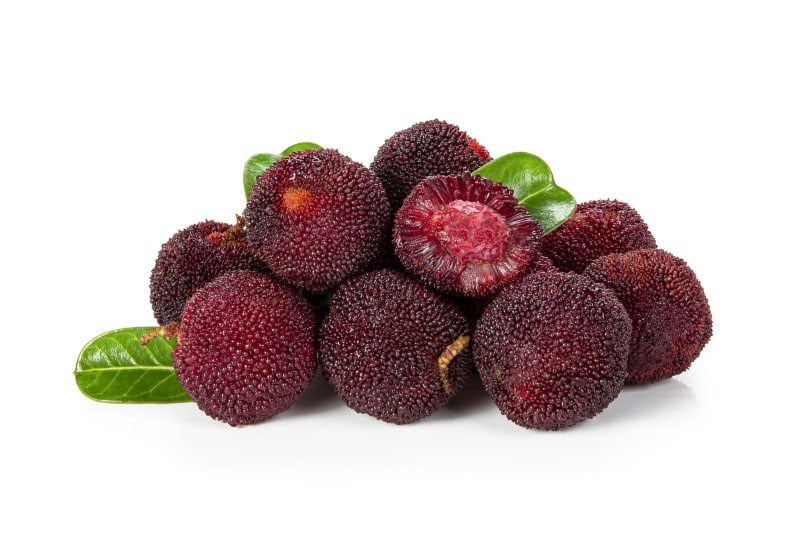
The Yangmei Fruit is scientifically known as Myrica rubra. The Yangmei fruit goes by different names, especially in its native home of east Asia. The fruit grows on a subtropical tree that grows to the height of up to 20 meters. The size of the Yangmei fruit is usually 1-3 centimeters wide, and its surface is always crimson red. Still, it may vary from purple to white, and the skin is usually a little bit thick. At the center of the fruit is a single seed that is almost half the size of the whole fruit. Yangmei is usually very sweet but leaves you with a tart aftertaste. Yangmei can be eaten raw and also used in cooking. Yangmei can be dried, baked with, candied, or used to flavor teas. Bright red Yangmei is often infused in baijiu (a clear liquor) to make fruit-flavored alcohol that can be sipped or cooked with other foods such as shrimp. Yangmei is a healthy fruit high in antioxidants, vitamins, and minerals, including vitamin C, thiamine, riboflavin, and carotene. These nutritional properties aid in reducing the risks of eye cataracts, blood pressure, lower your cholesterol helps fight inflammation, and boosts your immunity. Since Yangmei is mainly grown in East Asia, they happen to be very hard to acquire in the US since they are usually imported.
Yellow Plum
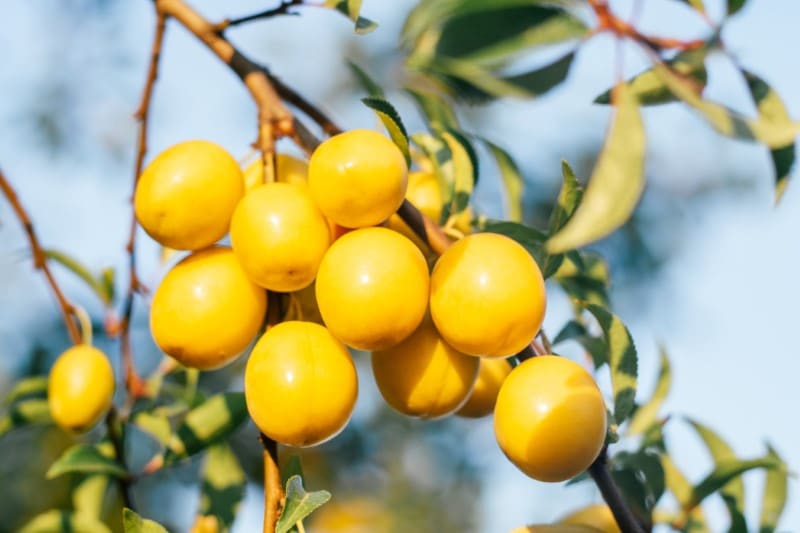
The yellow plum is also identified as the Mirabelle plum and scientifically as Prunus domestica, which is a cultivar group of plum trees. The Mirabelle plum is believed to have been first cultivated in the Anatolia region. The yellow plum is mostly oval-shaped, small in size, and with a very smooth-textured flesh. The yellow plum happens to be very sweet, but it tends to leave you with a tart aftertaste due to the skin. The flesh of the yellow plum is always rigid, but you can bite into it with ease. These plums are also used as cooking ingredients, mostly as a sweetener to help those seeking to cut back their sugar intake. The unique thing about these plums is that once they are picked, they stop producing sugar; thus, they don’t keep growing sweeter if they ripen off the tree. The plums can also be used in jam and jelly making or fermented to make plum wine. Other ways of eating yellow plums include poaching, baking, frying, salting, and grilling. These plums are a rich source of minerals such as calcium, magnesium, folate, phosphorus, potassium, and vitamins limited to vitamin C, A, and K. The nutrition value of these minerals and vitamins is unmatched in lowering anxiety, constipation pains, high blood pressure, stroke, and blood sugar. Yellow plums are very common in that they can be found in any region of the world.
Yellow Dragon Fruit
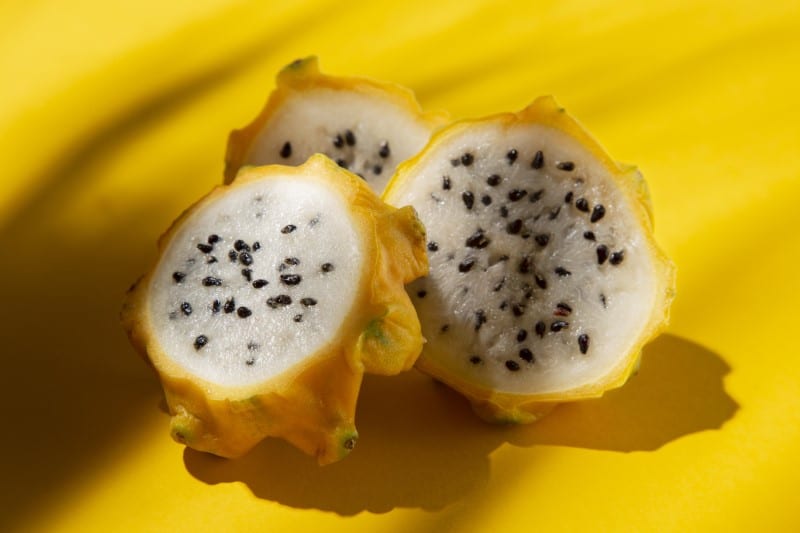
The yellow dragon fruit is scientifically recognized as Hylocereus megalanthus from the cactus family. The yellow dragon fruit is native to South America, where it is known as pithaya. The fruit is oval with a pikey yellow skin with black seeds and white inner flesh. There is a variety of the yellow dragon fruit, with the Australian gold being the variety that produces the largest fruits. The yellow dragon fruit is oblong and slightly smaller than the other varieties of dragon fruits. The fruit measures approximately 7 centimeters wide and 10 centimeters long though the size of the fruit is largely influenced by the climatic conditions of the growth area. The fruit possesses a mildly pleasant, sweet flavor with a juicy, crispy texture with no acidity. Typically, the yellow dragon fruit can be eaten raw. If you want to really enjoy this fruit, you are advised to refrigerate it for approximately 2 hours, and then you can enjoy it. The yellow dragon fruit can also be pureed and served as syrup or sauce or added to cocktails or smoothies and juice. Yellow Dragon fruit is a source of minerals such as potassium, phosphorus, and magnesium. The dragon fruit also contains protein and dietary fiber and has higher amounts of calcium than the red-skinned varieties. The yellow dragon fruit contains trace amounts of niacin, vitamins A and C, and iron. The Yellow Dragon fruit is also a good source of beneficial fatty acids and antioxidants. The edible seeds contain high amounts of omega-3 fatty acids that are beneficial for a healthy heart.
Youngberry
The youngberry is a hybrid between 3 different berry species: raspberry, dewberry, and blackberry. The scientific name of the youngberry is Rubus caesius. The youngberries tend to thrive in reach fertile clay soils. They are mostly cultivated on farms and gardens in the southern US, Australia, New Zealand, and South Africa. Youngberries have a very juicy red flesh, and when they ripen, they turn purple-black and cone-shaped. The berries are very sweet but leave you with a tart aftertaste. Youngberries can be eaten raw or used as an ingredient to prepare a wide range of food, especially pastries such as the youngberry cheesecake and pies like the youngberry pie. Also, the youngberries can be used to make juice, jelly, wine, liquor, syrup, and jam. These berries contain minerals like sodium, calcium, and potassium. They are also rich in proteins, and vitamins A, B, and C. The minerals and vitamins present in the fruits help maintain eyesight, strengthen bones, lower cholesterol levels, and aid indigestions. The youngberries are largely cultivated in the US; hence, they are easily available.
Yellow Sapote

The yellow sapote is scientifically recognized as Pouteria campechiana, yet it is canistel or the cupcake fruit to most people. It is native to the south American continent, yet it is also grown in parts of Africa and the Asian continent. The size of the fruit varies depending on the growth conditions. The fruit has got a fleshy yet pasty texture. The fruit also has a seed in its middle, which is usually brown. When the fruit is mature, the color turns into an intense yellow. The inner flesh of the fruit is yellow with a texture similar to that of a boiled egg. This fruit can be eaten raw or be turned into jam or marmalade and can be cooked by mixing it with flour to make pancakes or any flour-related delicacy. The fruit can also be blended with milk and other ingredients to make a milkshake or added with custard to make ice cream. Canistel is rich in minerals and vitamins such as vitamins A and C, iron, calcium, fiber, iron, and phosphorus. These minerals and vitamins help with bowel movements, promote stronger bones, boost your immune system, lower cholesterol levels in the body, and help fight acne.
Yellow Himalayan Raspberry

The yellow Himalayan raspberry is scientifically referred to as Rubus ellipticus, an Asian species of thorny fruity shrubs related to the rose family. These berries are native to India, Pakistan, China, and Nepal. The tree can grow to the height of up to 5 meters, though they are mostly shrubs. The fruits happen to be very sweet even though they are not usually harvested on a larger scale. The fruit’s flesh is usually tender, juicy, soft, and a little bit crunchy. The fruits are edible raw, cooked, blended into smoothies, or juiced to make refreshing beverages. Raspberries are a good source of antioxidants, including vitamin C, to boost the immune system, reduce inflammation, and protect the cells from free radical damage. The raspberries also contain fiber that aids in the digestion process, calcium to strengthen bones and teeth, iron to aid in producing the protein hemoglobin needed for oxygen transportation through the bloodstream, and other minerals like magnesium, calcium, manganese, iron, and copper.
The Final Letter
When it comes to fruits, you can never really exhaust them all since some fruits haven’t been discovered yet or have still not yet been fully studied. Each of the fruits above, starting with the letter Y, has a distinct feature that makes it unique. So, here’s a challenge for you using this list try and discover what feature is that.
